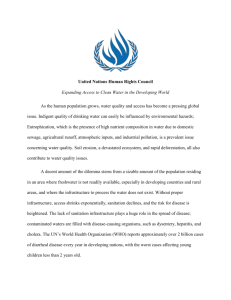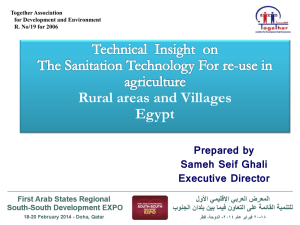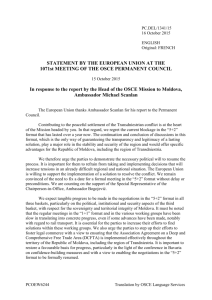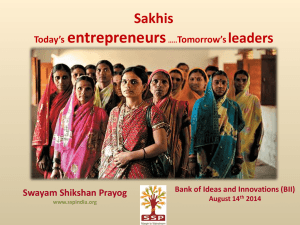'Water for Life' UN-Water Best Practices Award
advertisement
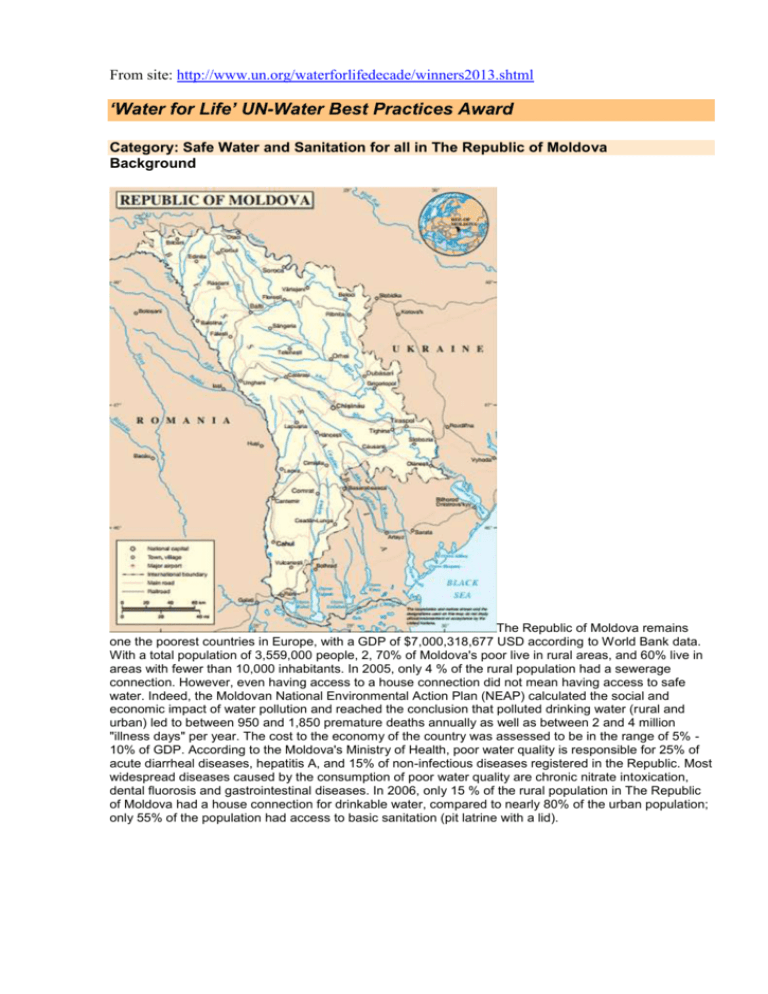
From site: http://www.un.org/waterforlifedecade/winners2013.shtml ‘Water for Life’ UN-Water Best Practices Award Category: Safe Water and Sanitation for all in The Republic of Moldova Background The Republic of Moldova remains one the poorest countries in Europe, with a GDP of $7,000,318,677 USD according to World Bank data. With a total population of 3,559,000 people, 2, 70% of Moldova's poor live in rural areas, and 60% live in areas with fewer than 10,000 inhabitants. In 2005, only 4 % of the rural population had a sewerage connection. However, even having access to a house connection did not mean having access to safe water. Indeed, the Moldovan National Environmental Action Plan (NEAP) calculated the social and economic impact of water pollution and reached the conclusion that polluted drinking water (rural and urban) led to between 950 and 1,850 premature deaths annually as well as between 2 and 4 million "illness days" per year. The cost to the economy of the country was assessed to be in the range of 5% 10% of GDP. According to the Moldova's Ministry of Health, poor water quality is responsible for 25% of acute diarrheal diseases, hepatitis A, and 15% of non-infectious diseases registered in the Republic. Most widespread diseases caused by the consumption of poor water quality are chronic nitrate intoxication, dental fluorosis and gastrointestinal diseases. In 2006, only 15 % of the rural population in The Republic of Moldova had a house connection for drinkable water, compared to nearly 80% of the urban population; only 55% of the population had access to basic sanitation (pit latrine with a lid). According to recent studies, 73% of the rural population has no access to safe drinking water. The rural citizens in The Republic of Moldova rely on small-scale water supply systems or on shallow wells which are often contaminated with micro-organism and nitrates. Latrines are the primary form of sanitation used, which is a significant source of environmental pollution. In addition, animal waste is often not adequately stored and treated, resulting in the cross contamination of water bodies. This has led to the degradation in aquatic flora and fauna in the river basins of the rivers Cubolta, Cainari, and Raut. According to surveys conducted by ORMAX ACT from 2008-10, it was discovered that nearly all macro-invertebrates have completely disappeared from the Cubolta, Cainari and Raut rivers. Primary factors of pollution such as human and poultry biological waste and sewage leaks are the chief causes for this drastic decline in aqua-fauna. In most villages along the aforementioned rivers, there are very few local strategies for improving water security. The initiative The Safe Water and Sanitation for all in The Republic of Moldova initiative was a project initiated by Ormax NGO to improve the situation in rural The Republic of Moldova by mobilizing citizens and the authorities to realize and respect the right to access safe water and sanitation through the sustainable management of local resources. Such implementation includes maintaining clean water sources to improve human health, which helps to maintain the environmental integrity of aquatic ecosystems, and thus contributes to protecting biological diversity. Objectives The project had the following three main objectives, defined by project partners, informed by empirical evidence of the feasibility study that was conducted that was used to prioritize local needs: Objective 1: Raising awareness of rural citizens of The Republic of Moldova, through community mobilization, about their fundamental right to clean water and sustainable sanitation. Objective 2: Capacity building of Moldavian communities in developing strategies for safe water and sustainable sanitation management. Objective 3: Advocating in front of local, national, and international decision makers to facilitate for rural citizens to receive an effective access to affordable and safe water and sustainable sanitation with the objective to encourage decision makers to effectively apply the right to water and sanitation in Moldova’s rural areas Target Targets were the 25,000 citizens of 10 selected villages in rural areas of Northern The Republic of Moldova. Villages were chosen that: possessed very poor access to safe water supply and sanitation relied on community and private wells, as well as rainwater stored in cement or plastic tanks. In rural Moldavian communities, severe nitrate contamination of wells is common and animal and human excreta are the main sources of contamination. Illegal waste dumps, of which 45-50% is animal "waste", often lead to surface water pollution and unsightly areas. The common economic activities in the areas are commercial and subsistence agriculture. The reason for focusing on villages that are set along river basins was that these populations live near the most polluted zones in the country and are most in need of assistance with environmental education, empowerment in terms of better political decision making, and carrying out ecological problems as prioritized by the local authorities. The strategy The main strategy for achieving the objectives was to promote the participatory practice of including local population in all of the stages of the project, combining educational activities (workshops, trainings) with practical activities (testing and mapping the wells, identifying the sources of pollution, cleaning activities) and demonstrating solutions for effective and affordable water protection in rural area as Ecosan toilets. Local involvement in the project was very significant: in each community a village committee was established which included: the mayor, the school director, 1-2 teachers and 1-2 parents and representatives of children involved in a Water Safety Plan (WSP). The village committee was responsible for project activities, implementation and communication with the village inhabitants and the local NGO partner. Public institutions, the regional council, and the teaching inspectorate supported project activities and their regional representatives were present in the communities during the core activities. The idea was for the local citizens, especially children, in the rural areas to develop their potential for acting locally and influencing policy-making and governance from the bottom-up. The outlined participatory activities served 30,000 people (5,000 more than what the project originally envisioned) educating them on the devastating dangers of unsafe water and sanitation practice, as well as sustainable steps that could be taken for prevention and improvement. The results The water quality measures were capitalized on maps that are available in the village halls and people can now avoid the most polluted sources of water. The impact of the activities is visible on community's behavior: no more solid waste is dumped near the public or private wells. Spring cleaning of wells is once again a tradition in the communities where awareness was raised during the project. It is now very important that the residents remain motivated. On one hand, they can take individual efforts for the protection of the water and their own health but, on the other hand, they have to continue to advocate with the authorities to ensure the proper governance of obligation. The empirical results of the program can be used as tools for the people of rural The Republic of Moldova as they lobby their authorities for better water infrastructure. Namely, the number of leaflets distributed, wells tested, meetings and workshops held, have all superseded the original planned numbers and now serve as parts of the toolbox that the people of The Republic of Moldova have. Public awareness has increased due to project activities: in all communities people are now aware about the negative impacts of substandard water quality on the human health, as well as the linkage between human and animal waste. The project has been a rich experience not only for the schools, but for the target villages as well. Participants agreed that the project was useful, though some expressed a feeling of being overwhelmed by the extent of the problems. In words of one project participant, "We learned much about our drinking water – how it is now and how it should be. We'll try now to change things". Cooperation at all levels of society The public participation was a determinant factor in the success of the project. However, only combining awareness raising activities with practical and demonstrational activities with an evident impact on people's life could the project maintain the public's cooperation and continued interest. Talking about the water quality without providing evidence that testing yielded would ever have gotten peoples' attention. This is also true about the sources of water pollution without identifying them. In conclusion, public involvement can be achieved only if the methods, the issues and the activities are adapted to public needs and capacities. Lesson learned was that in order to effectively introduce community based approach initial community mobilization and adapted trainings on relevant technologies are needed. Another factor of success was the authorities support and participation. The initiative involved local, regional, and national authorities in all the activities and found that their support motivated public participation. Besides capacity building for local authorities, the project organized a national conference putting together responsible bodies for water, sanitation and people's health. The results shared and the exchanges facilitated led to the definition of a certain number of activities in achieving the effective implementation of the right to water and sanitation in The Republic of Moldova. This strategy was sent to the ministries of environment and health and some of the proposals were integrated in the national strategy for water protection: the WSP were recognized by the national authorities as an effective tool in water protection at community scale and they are recommended by national authorities to be implemented in rural communities in order to protect the water resources by identifying the risks and reducing the water resources sources of pollution. In this particular project, the importance of involving authorities in the activities was crucial for achieving the project objectives and insuring the project sustainability. Developing activities with national authorities at all levels was a way to guarantee the coherence of the activities with local community's needs and possibilities and also a way to insure the sustainability of the activities after the project achievement.
